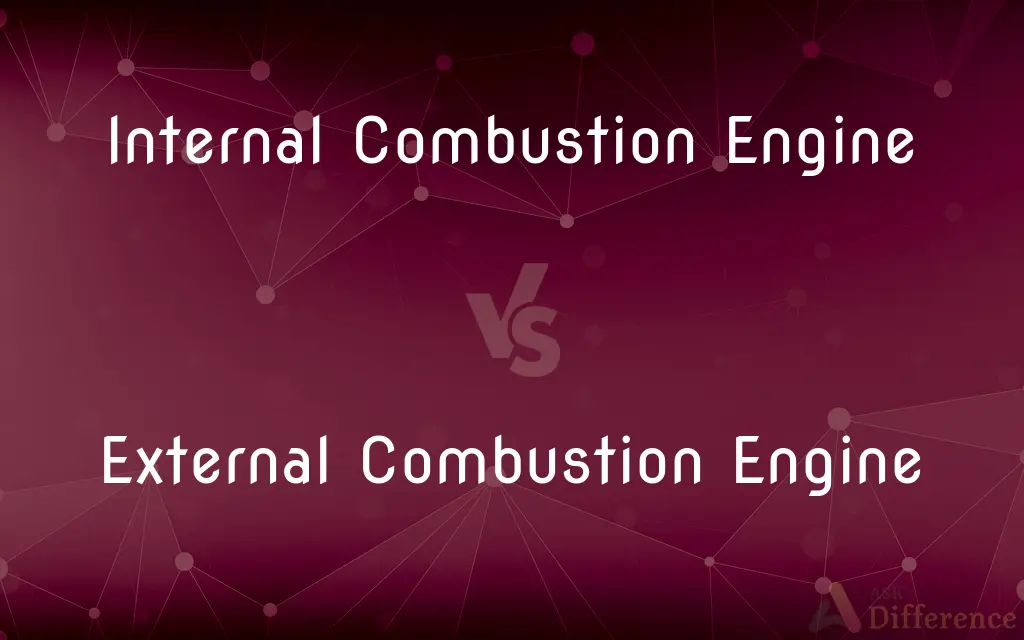Internal Combustion Engine vs. External Combustion Engine — What's the Difference?
By Tayyaba Rehman — Published on January 7, 2024
An internal combustion engine ignites fuel within the engine itself, while an external combustion engine burns fuel externally to heat a working fluid that powers the engine.

Difference Between Internal Combustion Engine and External Combustion Engine
Table of Contents
ADVERTISEMENT
Key Differences
Internal Combustion Engine (ICE) burns fuel within the engine itself. External Combustion Engine (ECE) burns fuel externally, using the heat to operate.
ICE is commonly found in cars and motorcycles. ECE is exemplified by steam engines.
ICE typically uses gasoline or diesel. ECE often uses coal or wood for fuel.
ICE is known for its compact size and high power-to-weight ratio. ECE tends to be larger and heavier.
ICE has fewer parts that interact with the working fluid. ECE has more parts, like boilers and condensers, that interact with the working fluid.
ADVERTISEMENT
Comparison Chart
Location of Combustion
Fuel burns inside the engine
Fuel burns outside, heats working fluid
Common Examples
Cars, motorcycles
Steam engines
Typical Fuel Used
Gasoline, diesel
Coal, wood
Size and Power Ratio
Compact, high power-to-weight ratio
Larger, heavier
Interaction with Working Fluid
Fewer parts interacting with working fluid
More parts, like boilers, interact with fluid
Compare with Definitions
Internal Combustion Engine
Engine where fuel combustion occurs internally.
The Internal Combustion Engine revolutionized transportation.
External Combustion Engine
Generates mechanical energy from external heat sources.
The External Combustion Engine in steamboats propelled river navigation.
Internal Combustion Engine
Power source where internal fuel combustion propels.
The Internal Combustion Engine has dominated automotive industries.
External Combustion Engine
Converts heat from external fuel burning into motion.
Old factories often used an External Combustion Engine for power.
Internal Combustion Engine
Converts fuel energy into mechanical motion inside.
Most cars use an Internal Combustion Engine.
External Combustion Engine
Engine where fuel combustion occurs externally.
The steam locomotive is powered by an External Combustion Engine.
Internal Combustion Engine
Compact engine with internal fuel burning.
The efficiency of the Internal Combustion Engine makes it popular in vehicles.
External Combustion Engine
Uses external fuel burning, transferring heat to fluid.
The External Combustion Engine was vital during the Industrial Revolution.
Internal Combustion Engine
Fuel burns inside, driving pistons and crankshaft.
The Internal Combustion Engine in my motorcycle provides rapid acceleration.
External Combustion Engine
Large engine with external fuel combustion.
The External Combustion Engine is less common in modern vehicles.
Common Curiosities
What fuels do Internal Combustion Engines commonly use?
They typically use gasoline or diesel.
Where are Internal Combustion Engines commonly used?
They're used in cars, motorcycles, and small machinery.
What is an Internal Combustion Engine?
It's an engine where fuel combustion occurs internally to generate power.
Are External Combustion Engines efficient?
They can be efficient but tend to be larger and heavier.
What fuels do External Combustion Engines commonly use?
They often use coal, wood, or other external heat sources.
What is an External Combustion Engine?
It's an engine where fuel burns externally and the heat is used to generate power.
Where are External Combustion Engines commonly used?
Historically, they were used in steam engines and industrial machinery.
Can Internal Combustion Engines use renewable energy?
They primarily use fossil fuels, but some can use biofuels.
Do Internal Combustion Engines emit pollutants?
Yes, they emit pollutants like CO2 and NOx.
Are Internal Combustion Engines efficient?
Yes, they are known for their high efficiency and power-to-weight ratio.
How long have External Combustion Engines been around?
They date back to the 18th century during the Industrial Revolution.
Can External Combustion Engines use renewable energy?
Yes, they can use various heat sources, including renewables.
Do External Combustion Engines emit pollutants?
They can emit pollutants depending on the fuel used.
How long have Internal Combustion Engines been around?
They've been in use since the late 19th century.
Are Internal Combustion Engines still evolving?
Yes, they are continually being improved for efficiency and emissions.
Share Your Discovery

Previous Comparison
Specific Heat vs. Heat Capacity
Next Comparison
Fox Terrier vs. Jack RussellAuthor Spotlight
Written by
Tayyaba RehmanTayyaba Rehman is a distinguished writer, currently serving as a primary contributor to askdifference.com. As a researcher in semantics and etymology, Tayyaba's passion for the complexity of languages and their distinctions has found a perfect home on the platform. Tayyaba delves into the intricacies of language, distinguishing between commonly confused words and phrases, thereby providing clarity for readers worldwide.
















































